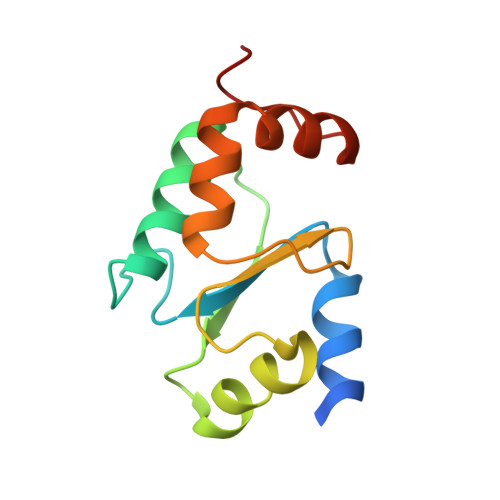The Crystal Structure of Human Glrx5: Iron Sulphur Cluster Coordination, Tetrameric Assembly and Monomer Activity.
Johansson, C., Roos, A.K., Montano, S.J., Sengupta, R., Filippakopoulos, P., Guo, K., von Delft, F., Holmgren, A., Oppermann, U., Kavanagh, K.L.(2011) Biochem J 433: 303
- PubMed: 21029046
- DOI: https://doi.org/10.1042/BJ20101286
- Primary Citation of Related Structures:
2WUL - PubMed Abstract:
Human GLRX5 (glutaredoxin 5) is an evolutionarily conserved thiol-disulfide oxidoreductase that has a direct role in the maintenance of normal cytosolic and mitochondrial iron homoeostasis, and its expression affects haem biosynthesis and erythropoiesis. We have crystallized the human GLRX5 bound to two [2Fe-2S] clusters and four GSH molecules. The crystal structure revealed a tetrameric organization with the [2Fe-2S] clusters buried in the interior and shielded from the solvent by the conserved β1-α2 loop, Phe⁶⁹ and the GSH molecules. Each [2Fe-2S] cluster is ligated by the N-terminal activesite cysteine (Cys⁶⁷) thiols contributed by two protomers and two cysteine thiols from two GSH. The two subunits co-ordinating the cluster are in a more extended conformation compared with iron-sulfur-bound human GLRX2, and the intersubunit interactions are more extensive and involve conserved residues among monothiol GLRXs. Gel-filtration chromatography and analytical ultracentrifugation support a tetrameric organization of holo-GLRX5, whereas the apoprotein is monomeric. MS analyses revealed glutathionylation of the cysteine residues in the absence of the [2Fe-2S] cluster, which would protect them from further oxidation and possibly facilitate cluster transfer/acceptance. Apo-GLRX5 reduced glutathione mixed disulfides with a rate 100 times lower than did GLRX2 and was active as a glutathione-dependent electron donor for mammalian ribonucleotide reductase.
- University of Oxford, UK. catrine.johansson@sgc.ox.ac.uk
Organizational Affiliation:




















